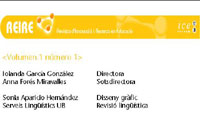Compilation, classification and evaluation of animations and simulations for teaching biology at the compulsory secondary education level
DOI:
https://doi.org/10.1344/reire2008.1.1115Keywords:
Animations, simulations, compulsory secondary education, evaluationAbstract
A large number of studies have shown that visualising processes in 3-D images aids learning. Animations and simulations have proved to be an extremely effective resource for compulsory secondary education (ESO) students, as it enables them to “see” models and situations that otherwise are often too abstract for them. This article describes the characteristics of these resources and the strategies for implementing them in the classroom. At first sight, finding such resources on the internet would appear to be an easy matter, as there is a lot of such material available. On closer examination, however, it turns out that it is quite hard to find good ones. A list of 58 websites and 398 resources was compiled, and they were classified and evaluated. The intention is that providing as much information as possible about these resources and explaining the criteria used to evaluate them will make them more useful for secondary school biology teachers who would like to employ them.References
BICK, A. (2006). Becoming a Virtual Organism to Learn about Genetics. Crossroads. The ACM Student Magazine, 13 (1).
CHANLIN, L.J. (1998). Animation to teach students of different knowledge levels. Journal of Instructional Psychology, 25, 166-175.
ECKERT, B.; ALTHERR, S.; JODL, H.J. (2003). Multimedia in teacher training. Contributin 2nd International GIREP Seminar, Udine.
EIDSON, S.; SIMMONS, P.E. (1998). Microcomputer simulation graphic and alphanumeric modes: examining students’ process skills and conceptual understandings. Journal of Computers in Mathematics and Science Teaching, 17, 21-61.
KORFIATIS, K.; PAPATHEODOROU, E.; STAMOU, G.P.; PARASKEVOPOULOUS, S. (1999). An investigation of the effectiveness of computer simulation programs as tutorial tools for teaching population ecology at university. International Journal of Science Education, 21, 1269-1280.
MCFARLANE, A.; SAKELLARIOU, S. (2002). The role of ICT in Science Education. Cambridge Journal of Education, 32, 219-232.
Downloads
Published
How to Cite
Issue
Section
License
Authors keep authorship rights and confer to REIRE the rights of article’s first publication.
All the contents included into REIRE Revista d’innovació i Recerca en Educació are under Creative Commons 4.0 International license attribution, which allows the article’s reproduction, distribution and public communication, whenever authorship and the journal’s title is quoted.







